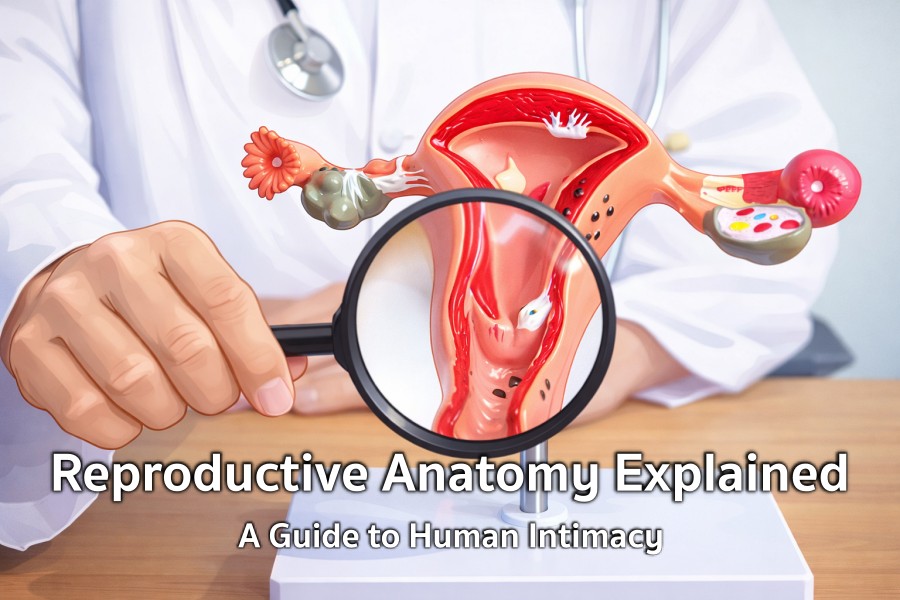Understanding reproductive anatomy is important for everyone, regardless of gender. Knowledge about our bodies not only helps us better understand ourselves, but also enables us to take proper care of our sexual health, while fostering safer and more fulfilling sexual relationships. In this article, we will guide you through an exploration of the reproductive anatomy of both men and women, including the organs involved in reproduction and sexual pleasure.
List of Contents
- Female Reproductive Anatomy
- Male Reproductive Anatomy
- Changes in Genital Organs Across Different Life Stages
- Genital Hygiene Care
- Sexual Anatomy and LGBTQ+
- Transgender
- Hormone Replacement Therapy – HRT
- Gender Reassignment Surgery
- Intersex
- Sexual Health Care for LGBTQ+
- The Importance of Embracing Diversity
Female Reproductive Anatomy
Reproductive Anatomy – Female: External Genitalia
Vulva
The vulva is the collective term for all of the external female genitalia, consisting of the following parts:

- Vagina: A canal that serves as the passage for sexual intercourse and childbirth.
- Urethra: A small tube located between the clitoris and the vaginal opening, responsible for urination.
- Labia Majora: The outer folds of skin that cover the internal genital structures, containing sebaceous glands and pubic hair.
- Labia Minora: The thinner inner folds of skin located inside the labia majora, rich in blood vessels and nerves, making them highly sensitive to touch.
- Clitoris: A small organ situated at the top of the vaginal opening, whose primary function is to provide sexual pleasure.
Clitoris
The clitoris is one of the most important organs for female sexual pleasure, with the following characteristics:
- When stimulated, the clitoris enlarges and becomes slightly erect.
- Although small in size, it contains around 8,000 nerve endings.
- Stimulation of the clitoris is the primary way that most women experience sexual pleasure and reach orgasm.
- The majority of the clitoral structure is hidden inside the body, with only the external glans visible outside.
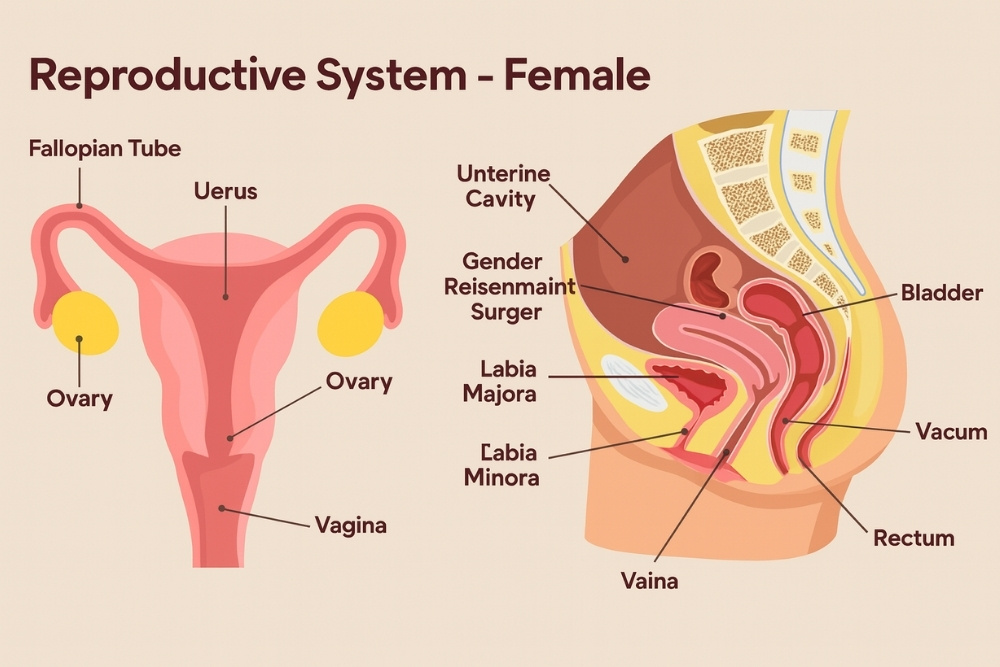
Female Reproductive Anatomy – Internal Organs
Vagina
The vagina is a muscular, flexible canal with the following characteristics:
- Composed of muscles that can contract and relax.
- The vaginal walls contain glands that produce natural lubrication.
- Functions as the passage for menstrual blood, sexual intercourse, and childbirth.
- Typically measures around 7–10 centimeters in length but can expand significantly during sexual arousal or childbirth.
Uterus
The uterus is a vital organ in the female reproductive system, with these features:
- Shaped like an inverted pear.
- The uterine wall consists of very strong smooth muscle.
- In the absence of pregnancy, the endometrial lining sheds as menstrual blood.
- During pregnancy, the uterus expands to accommodate the growing fetus.
- The innermost lining, called the endometrium, thickens each cycle to prepare for the implantation of a fertilized egg.
Fallopian tubes
The fallopian tubes are small ducts connecting the ovaries to the uterus, with the following characteristics:

- Each tube is about 10–12 centimeters long.
- Fertilization of the egg by sperm usually occurs in the fallopian tube.
- Tiny hair-like structures (cilia) inside the tube help transport the egg from the ovary to the uterus.
Ovaries
The ovaries are the female reproductive glands with these characteristics:
- Women have two ovaries, located on either side of the uterus.
- Almond-shaped, measuring approximately 3–5 centimeters.
- Responsible for producing eggs and female hormones such as estrogen and progesterone.
- Each month, the ovary releases a mature egg (sometimes more than one), a process known as ovulation.
Male Reproductive Anatomy
Male Reproductive Anatomy: External Genitalia
Penis
The penis is the male reproductive organ that also serves as the passage for urination. Its characteristics include:
- When sexually aroused, blood flows into erectile tissues, causing the penis to become erect.
- The tip of the penis is called the glans penis, which is highly sensitive to touch.
- It is composed of two erectile tissues (corpora cavernosa) and one spongy tissue (corpus spongiosum).
- Penis size varies among individuals. On average, when flaccid it measures about 9–10 cm, and when erect about 12–16 cm in length.
Scrotum
The scrotum is a pouch of skin that encloses and protects the testes, with the following characteristics:
- It appears as a wrinkled sac with thin skin and pubic hair covering it.
- The scrotum can contract and relax to regulate the temperature of the testes, keeping it suitable for sperm production.
- Normally, the scrotum hangs away from the body to maintain a temperature about 2–3°C lower than core body temperature, which is optimal for sperm development.
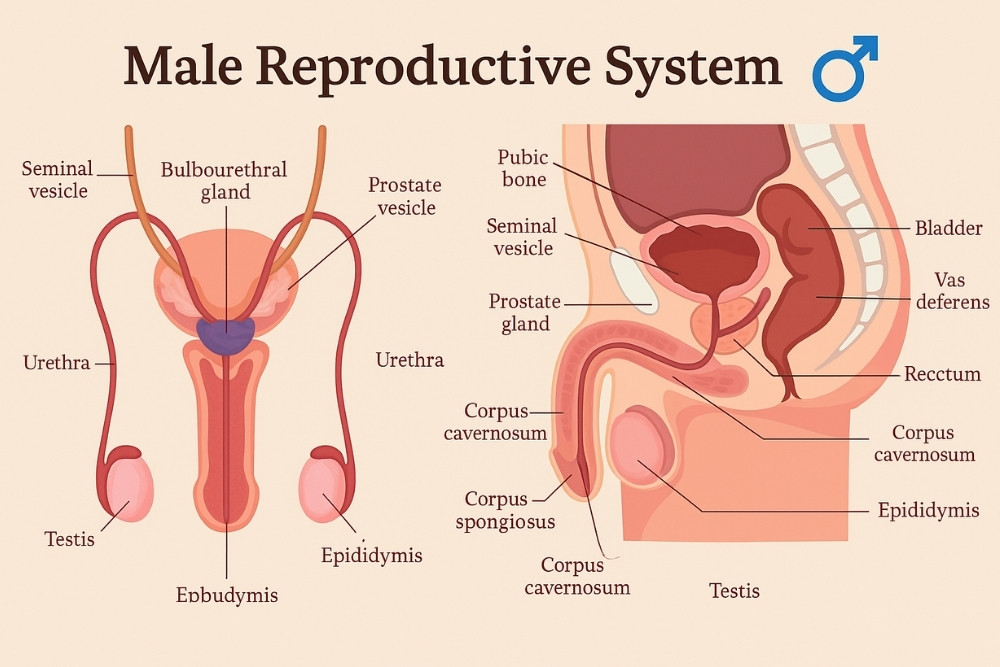
Male Reproductive Anatomy: Internal Organs
Testes
The testes are the male reproductive glands with the following characteristics:
- Men have two testes, located inside the scrotum.
- Oval in shape, measuring about 4–5 centimeters in length.
- Responsible for producing sperm and male hormones, particularly testosterone.
- Contain numerous tiny seminiferous tubules where sperm is produced and stored.
Vas deferens
The vas deferens is the duct that transports sperm from the testes to the urethra:
- Approximately 30–35 centimeters long.
- Connects the epididymis to the prostate gland.
- Surrounded by thick smooth muscle that contracts to help propel sperm forward.
Prostate gland
The prostate gland is a vital organ in the male reproductive system with these features:
- Plays a significant role in sexual sensation and orgasm.
- About the size of a walnut, located below the bladder and surrounding the upper urethra.
- Produces fluid that is a key component of semen, aiding in lubrication and providing energy for sperm.
Seminal vesicles
The seminal vesicles are glands that produce fluid contributing to semen:
- Small sacs located behind the prostate gland.
- Their fluid accounts for about 70% of the total semen volume.
- This fluid is thick and viscous, containing fructose, proteins, and other substances essential for sperm survival.
Cowper’s Glands (Bulbourethral Glands)
The Cowper’s glands are small glands located beneath the prostate:
- Secrete a clear fluid released before ejaculation.
- This fluid helps cleanse and lubricate the urethra, as well as neutralize its acidity to create a suitable environment for sperm.
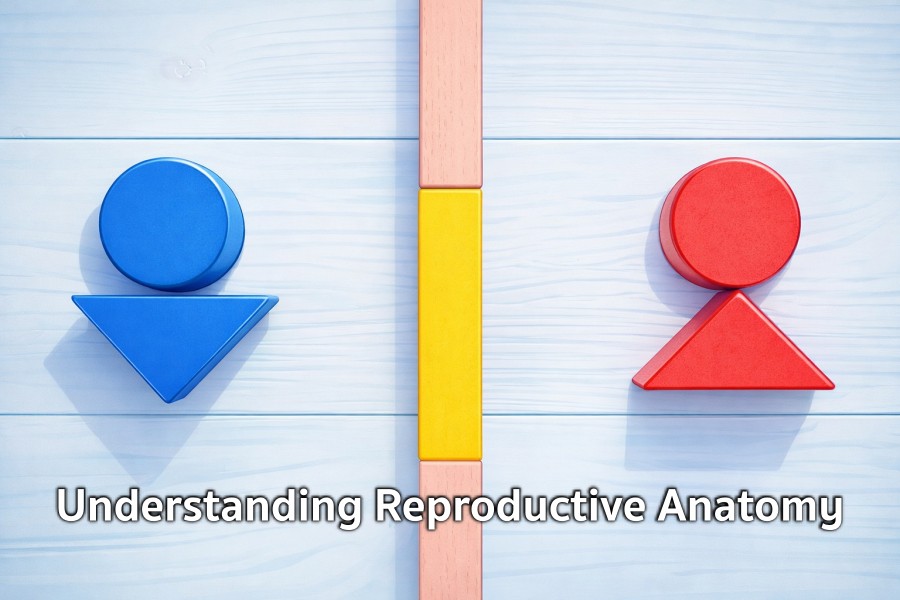
| Reproductive Organs |
|---|
| External – External reproductive organs include the penis and scrotum, which function to produce sperm through the testes. |
| Internal – Internal reproductive organs include the uterus, ovaries, and vagina, which are responsible for producing eggs and supporting pregnancy. |
| Genital Organs |
|---|
| External – The external genital organ is the penis, which develops during puberty alongside muscle growth and body hair. |
| Internal – The internal genital organs include the testes and prostate gland, which are involved in sperm production, secondary sexual characteristics (such as body hair), the menstrual cycle, and pregnancy. |
| Musculoskeletal Structure |
|---|
| Male – Generally has larger muscle mass and denser bones, especially in the shoulders and hips. |
| Female – Has a wider pelvic bone to support pregnancy, with relatively smaller muscle mass. |
| Breasts |
|---|
| Male – Breasts are underdeveloped but still contain nipples and glandular tissue. |
| Female – Breasts fully develop during puberty and play a crucial role in milk production for infant feeding. |
| Body Fat Distribution |
|---|
| Male – Typically has lower body fat, mostly stored in the abdominal area. |
| Female – Has greater fat accumulation in the hips, thighs, and breasts. |
| Voice and Body Hair |
|---|
| Male – Deeper voice and more facial and body hair, influenced by testosterone. |
| Female – Higher-pitched voice and less body hair compared to males. |
Changes in Genital Organs Across Different Life Stages
The genital organs of both males and females undergo changes throughout life, particularly during adolescence and menopause/andropause.:
| Adolescence |
|---|
| Male: The penis and testes enlarge, sperm production begins, and the voice deepens. Other body changes include increased body hair growth and greater muscle development. |
| Female: Breasts begin to develop, menstruation occurs for the first time, and the body undergoes changes in overall shape. |
| Adulthood |
|---|
| Male: Genital size stabilizes, with sperm and testosterone production reaching peak levels. |
| Female: Menstrual cycles become regular, and the reproductive system is fully prepared for pregnancy and childbirth. |
| Menopause / Andropause (Later Adulthood) |
|---|
| Male: Testosterone production gradually decreases, which may lead to erectile difficulties or reduced sexual function. |
| Female: Female hormone production declines, menstruation ceases, and menopause symptoms may appear, such as vaginal dryness or thinning of the vaginal wall. |
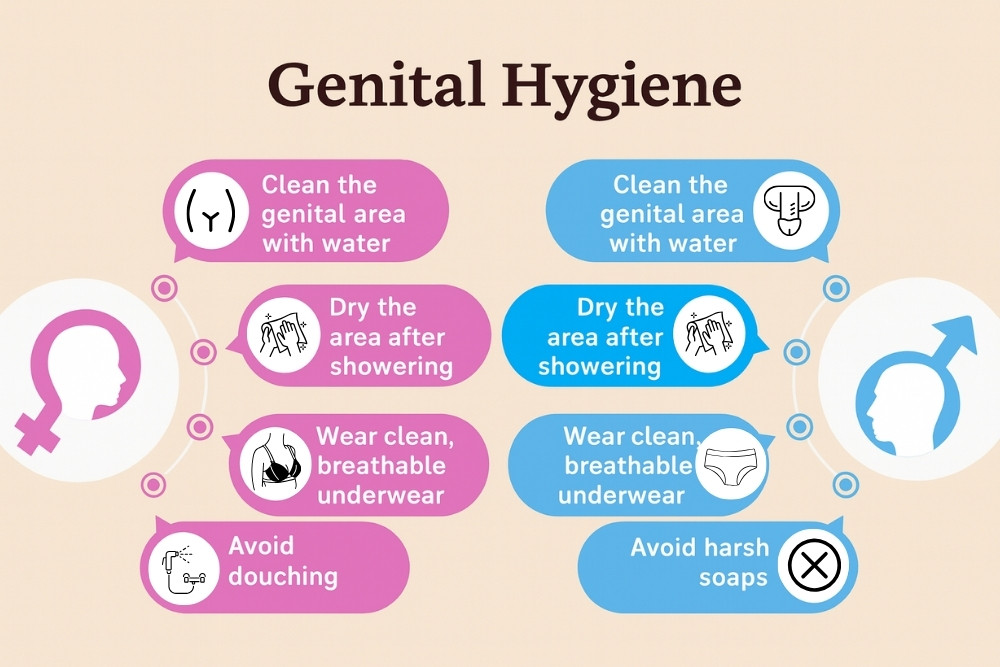
Reproductive Anatomy – Genital Hygiene Care
Proper genital hygiene is essential for both men and women to prevent infections and maintain good sexual health:
For Women
- Clean the external genital area regularly with clean water. Special soaps or cleansers are generally unnecessary.
- Always dry the area after washing or urination. Wipe from front to back to prevent bacteria from the anus from reaching the vagina.
- Wear clean underwear made from breathable fabrics.
- Avoid unnecessary vaginal douching, as it can disrupt the balance of beneficial bacteria in the vagina.
- Have regular gynecological check-ups, including examinations of the vagina and uterus, as recommended by a doctor.
For Men
- Wash the penis and scrotum regularly with clean water, paying special attention to the area under the foreskin if uncircumcised.
- Dry the genital area after washing or urination.
- Wear clean, breathable underwear.
- Avoid using soaps or cleansers with harsh chemicals on the genital area.
- Undergo regular prostate health check-ups, especially as you get older.
Reproductive Anatomy and LGBTQ+
When discussing sexual anatomy, it should not be limited only to male and female bodies assigned at birth. In reality, human beings have diverse sexualities and identities beyond the binary. The LGBTQ+ community (Lesbian, Gay, Bisexual, Transgender, Queer, and others) reflects diversity in terms of gender identity and gender expression, which may influence sexual anatomy in various ways.
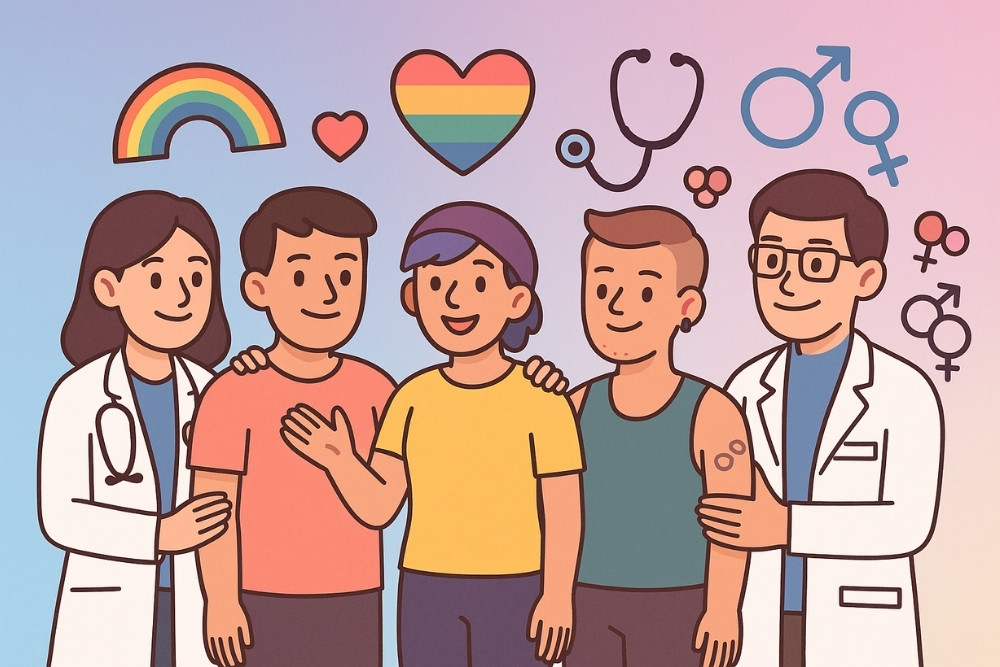
Reproductive Anatomy Transgender
A transgender person is someone whose gender identity does not align with the sex assigned to them at birth. These individuals may choose to alter their bodies to better match their gender identity, which can affect sexual anatomy in the following ways:
Hormone Replacement Therapy – HRT
- Male to Female (MTF) Transgender Women: Estrogen therapy may lead to breast development, redistribution of body fat in a typically female pattern, and reduced body hair.
- Female to Male (FTM) Transgender Men: Testosterone therapy may cause a deeper voice, increased body hair growth, and redistribution of body fat in a typically male pattern.
Gender Reassignment Surgery
- Transgender Women: May undergo vaginoplasty (creation of a vagina) and breast augmentation.
- Transgender Men: May undergo top surgery (removal of breasts) and procedures to construct a penis, such as phalloplasty or metoidioplasty.
Reproductive Anatomy Intersex
Intersex people are those born with physical traits, hormones, or chromosomes that do not fit typical definitions of male or female. Intersex anatomy may present in diverse forms, for example:
- External genitalia that appear ambiguous and do not clearly resemble either male or female.
- Presence of both male and female internal reproductive structures.
- Chromosomal variations outside of XX (female) or XY (male), such as XXY or XO.
Sexual Health Care for LGBTQ+
- Annual Health Check-ups
- It is recommended to receive annual health check-ups from healthcare providers who are knowledgeable and sensitive to gender and sexual diversity.
- Prevention of Sexually Transmitted Infections (STIs)
- Always use condoms or dental dams during sexual activity and undergo regular STI screenings.
- Mental Health
- Prioritize mental health and seek emotional support when needed, as LGBTQ+ individuals may face unique stressors and experiences of discrimination.
- Post-Gender Affirmation Surgery Care
- For those who have undergone gender affirmation surgery, it is crucial to follow medical guidance strictly regarding wound care and the maintenance of newly constructed anatomy.
- Hormone Use
- For individuals undergoing hormone replacement therapy (HRT), treatment should always be supervised by healthcare professionals, alongside regular health monitoring.
The Importance of Embracing Diversity
Understanding and accepting sexual and gender diversity is vital for building an inclusive and equitable society. Learning about the sexual anatomy and health of LGBTQ+ individuals not only broadens our understanding of human diversity but also helps reduce prejudice and discrimination born from misunderstanding.
Regardless of gender identity or expression, everyone has the right to receive appropriate healthcare and to be treated equally in society. Education and awareness about sexual and gender diversity are therefore essential steps toward fostering respect, acceptance, and equality for all.

Related Article
Understanding your own sexual anatomy is important for everyone. It not only enables you to take proper care of your sexual health, but also helps you better understand how your body functions and communicate more effectively with your partner or healthcare provider. Knowledge about sexual anatomy can also reduce feelings of embarrassment or anxiety about one’s body and foster a healthier, more positive attitude toward sexuality.
In addition, such understanding allows you to recognize potential abnormalities and seek medical help in a timely manner. Above all, it is essential to remember that every body is unique. Variations in shape, size, and the appearance of genitalia are completely normal. Accepting and respecting these differences—both in yourself and in others—is a key part of maintaining good sexual health and building fulfilling relationships.
Reference:
ระบบสืบพันธุ์เพศชาย
ระบบสืบพันธุ์เพศหญิง
กายวิภาคศาสตร์ และสรีรวิทยาสำหรับปฏิบัติการฉุกเฉินการแพทย์
- nms.nmd.go.th
